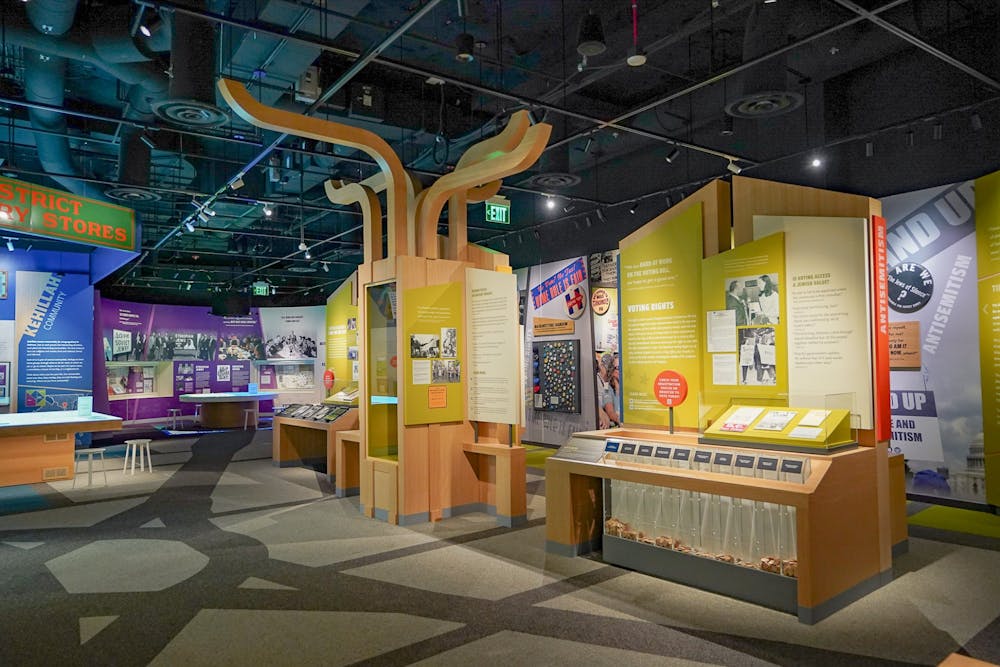The Lillian and Albert Small Capital Jewish Museum opened its doors to the public June 9, making it the first museum dedicated entirely to telling the story of Jewish life in the nation’s capital.
The 32,000-square-foot, four-story museum sits at the corner of 3rd and F Streets NW, one block from the Judiciary Square Metro station.
Lillian and Albert Small, the museum’s namesakes, were major supporters of the former Jewish Historical Society of Greater Washington whose descendants in 2017 donated “the lead gift to build the expanded museum,” Maura Scanlon, a museum spokesperson said in an email.
The museum’s curator, Sarah Leavitt, wanted to tell the full history of Jewish life in D.C. — celebrating successes and recognizing problems — all while questioning what, if anything, defines “Jewish Washington.”
“We’re not just here to say the good things,” Leavitt, told The Eagle in a walkthrough of the main exhibition on June 8.
Leavitt and Scanlon pointed out that the museum displays a variety of Jewish experiences in the District, from that of a Confederate spy to a 1950s championship bowler.
The exhibition also acknowledges influential Jewish Washingtonians such as the journalist Judith Martin, the lawyer and economist Bill Dauster, who has managed the U.S. Senate passage of major legislation including the Affordable Care Act, and the activist Nettie Ottenberg, one of the organizers of the 1913 Woman Suffrage Procession down Pennsylvania Avenue.
The main exhibition, titled “Connect. Reflect. Act,” connects the original structure of the Adas Israel Synagogue, the oldest synagogue in D.C., to the modern addition. The museum’s opening coincides with the 147th anniversary of the synagogue’s dedication.
Scanlon said that the connection — a literal bridge from the historic sanctuary to the main exhibition on the museum’s second floor — symbolizes the museum’s current relevance and historical contents.
She called the synagogue “our largest and best-known artifact.”
The purpose of the exhibition is to “connect with the stories of Jewish Washingtonians,” according to a sign at the entry of the exhibition. “You can reflect on these histories and explore the ways you can act to build a better future — because you are here.”
“Connect. Reflect. Act.” contains signs from local Jewish businesses, photographs of more than 100 influential Jewish Washingtonians, protest signs and dozens more relics.
The five sections of the exhibition, which each have names in English and Hebrew, ask visitors to consider the many aspects of Jewish life in D.C. — different from life in other cities because of D.C. residents’ proximity to power, said Scanlon.
“Being the nation’s capital, we had a greater responsibility or sense of responsibility because Jewish members of the Congress went to our synagogues,” reads a quote from Jewish advocate Hyman Bookbinder on the wall of the exhibit.
One influential former lawmaker is being commemorated with their own visiting exhibition by the Skirball Cultural Center in Los Angeles. The third floor of the museum focuses on the late Supreme Court Justice Ruth Bader Ginsburg, who was the first Jewish woman and the second woman to ever serve on the Supreme Court.
Titled “Notorious RBG: The Life and Times of Ruth Bader Ginsburg,” the exhibit takes its inspiration from a popular comparison between Ginsburg and the famous rapper The Notorious B.I.G., both of whom are natives of Brooklyn, New York. Each section of the exhibition is named after lyrics from a Notorious B.I.G. song.
The exhibition brings visitors from Ginsburg’s childhood to her time on the Supreme Court, and features recreations of her Brooklyn apartment and her desk while on the high court, descriptions of her most significant rulings, her Supreme Court robes and her famous collar.
General museum admission, which includes the exhibition “Connect. Reflect. Act,” is free. “Notorious RBG” will be at the Capital Jewish Museum until November 30, and costs $10 for students and adults ages 65 and over, $12 for visitors under 65 and is free for children 12 and under.
The museum will offer memberships, starting at $36 for students, $54 for individuals and $180 for households. Members enjoy free admission to all exhibitions and discounts on programs.
This article was edited by Abigail Hatting, Jordan Young and Abigail Pritchard. Copy editing done by Isabelle Kravis.





